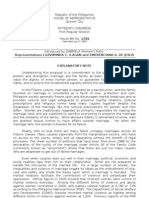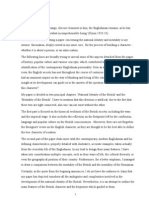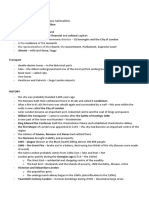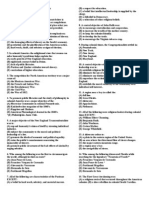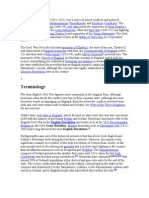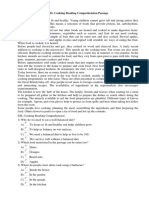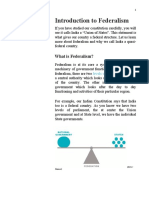American Civilization Questions/onsets
American Civilization Questions/onsets
Uploaded by
Niels TacomaCopyright:
Available Formats
American Civilization Questions/onsets
American Civilization Questions/onsets
Uploaded by
Niels TacomaOriginal Title
Copyright
Available Formats
Share this document
Did you find this document useful?
Is this content inappropriate?
Copyright:
Available Formats
American Civilization Questions/onsets
American Civilization Questions/onsets
Uploaded by
Niels TacomaCopyright:
Available Formats
1. American exceptionalism means: The Americans unique mission in the world, idealism, high aspirations and sense of destiny.
2. Americanization is: The adaption to mainstream American culture. 3. Which best describes US immigration statistics in 2000? Natural forces of integration have grown and a sense of civic commonality or a distinctive American nationalism has increased. 4. The Old Glory is another name for: The American flag (Stars and Stripes, Star-Spangled Banner). 5. American traits are typically held to include: -Self-reliance -Individualism -Independence -Utopianism -Liberty -Egalitarianism -Freedom -Opportunity -Democracy -Anti-statism (distrust for government) -Populism (grass-roots activism) -Sense of destiny -Respect for the law 6. Which of the following best reflects the role of colonization and immigration in US culture? Many people see their roots as European, but immigration and integration has weakened the bonds with immigrant roots, particularly in later generations. 7. Which of the following US demographic developments has been projected in the near future? ??
8. Which of the following most closely represents the American judicial system? US Supreme Court in Washington DC. The Constitution is central. 9. Which of the following best describes American politicians? They most of all promote their own constituency legislation as a response to local and regional pressures. 10. Which of the following is the primary focus of American politics? More influenced by local, special, regional or state interests than national matters. Normally not considered to be as oppositional as in other nations. 11. Which of the following is typical of American voters: They often vote simultaneously in election lists for political representatives from different political parties who support specific issues. 12. Which of the following is true of American voting behavior: Zie 11. There is debate about whether or not there have been apathy and low political participation among US voters in recent decades. This may suggest alienation from the political process (p. 8+9). 13. Which of the following is true of the American mentality? The people historically have had to fight for their economic and social survival, a process which can result in exploitation of others, excesses and a Darwinial survival of the fittest mentality. 14. Nativist undercurrents in US public opinion That immigration (legal and illegal) is a problem, which is at odds with the values of much of the countrys political and economic leadership. 15. Which of the following most characterizes American culture? American exceptionalism. The American Dream (working hard is rewarded). 16. Which of the following was NOT, according to Mauk & Oakland, a motivation for colonists to come to the New World? Wel: -Religious inspiration.
-Adventure. -New experiences. -Escape from European habits. -Material gain. -Acquisition of land. 17. Which of the following most closely represents the place of religion in US society? There is a large diversity of faiths, for immigrants often keep to their home faiths. It is desired to keep religion out of politics. Religion is a private matter. 18. Which of the following is NOT a result of social pluralism? Wel: -Large diversity of religions. -Fragmentation. -Questions about national identity. -Attempts to Americanize immigrants (assimilation instead of integration). -Possible risk for American society because of competing cultures and interest groups, each claiming a right to special treatment. 19. Among those who arbitrate whether political action is constitutional in the US are: The US Supreme Court in Washington DC. 20. Which of the following is typical of US political campaigns? Represent an idealistic and abstract image of the nation. 21. Which of the following is true about the state of capitalism in the US? There is significant economic cooperation, charitable organizations and volunteerism in American society. But the market can also produce inferior products, bad service, incompetence, corruption and little variety or real choice for consumers (p. 10). 22. e pluribus unum: Out of many one. May not be practically achievable.
-Commercial fertilizers and oil-drilling in the South. 2. Which of the following is NOT true regarding Appalachia? Wel: -In Pennsylvania and West Virginia. -Contains the largest coal deposits that once provided fuel for developing industry in the north-east and the Great Lakes region as well as for heating homes across the nation. -Today it is the nations most depressed area because there is not as much need for coal anymore (other resources, coal is cause or air pollution and acid rain). 3. Which of the following does NOT describe the Central Lowland? Wel: -Stretches from New York state to central Texas and north to Canada. -Hugh irregular bowl rimmed by the Great Lakes and highlands. -Iron ore in Mesabi Range important for Americas early industry. -Not entirely flat. Also a rocky territory with many lakes. -Varies in rainfall and temperature. -Often calls the nations breadbasket. -Natural resources are its soil and fossil fuels. 4. Which of the following is TRUE concerning the maritime riches of the US and Canada? Great Banks contained many kinds of fish attracted many fishermen cod stocks collapsed from international over-fishing. 5. Which of the following best describes the Great Lakes? The biggest group of freshwater lakes in the world. Fertile farmland surrounds them. 6. Which of the following is TRUE concerning wildlife preservation in the USA? -Wildlife is preserved in state and local parks and open spaces. -National parks gained acceptance in the late 1800s. -Yellowstone National Park was the first nature preserve created by Congress.
1. Which of the following is NOT a considerable threat to the environment of the Atlantic Plains? Wel: -water pollution from industrial development in the North.
7. Which of the following do some consider a serious flaw in the ideal of the multiple use of national parks? It may have worked when the west was underpopulated, but today it satisfies no one and could lead to the loss of irreplaceable resources. 8. Which of the following is NOT true concerning environmental laws in the USA? True: -Environmental Protection Agency (EPA) has taken on the national governments responsibility for monitoring and protecting Americas natural environment. -Clean Air Act gave the EPA the duty of reducing airborne pollutants. -Safe Drinking Water Act and the Superfund statute, provides emergency federal funding for eliminating the health hazards of toxic-waste sites across the nation. 9. Which of the following is NOT true regarding Native-American cultures? True: -Women and children usually farmed while men hunted and fished. -Maize/corn was the most important part of the NativeAmerican culture. -Conflicts with other cultures emerged when groups exploited their land and moved to a new land. -p. 38-39 10. Which of the following was the main cause for the growth of the Native American population in the Great Plains during the early 1800s? They discovered how to use horses plains cultures were transformed. The food supply increased dramatically when bison were hunted on horseback population grew, sometimes migrated. 11. The north-west coastal peoples -lived in villages similar to independent city states. -did not need to farm. Fishing was primary economic activity: salmon, saltwater fishing and whaling. -made long seagoing canoes and massive wooden lodges. -Well-known for the potlatch (=several days of feasting with extravagant gifts for the guests). -One of the few non-agricultural societies to practice slavery.
12. Which view on native cultures and their relation to land comes from a glamorized image of North America before European settlement? The view that land had only spiritual value to the natives. 13. Which of the following is NOT a principal cause for the homogenization of the American population? Wel: -High mobility of the American population. popular mass culture, modern transportation, urbanization, centralization of economy and government. 14. Which of the following is one of New Englands main strengths compared to other areas? It is the nations economic and cultural center. Quality institutions of education and research. 15. What were the original intentions of the first colonists of the South? Founding a model religious community that would inspire reform in England. 16. What was the main cause for the agricultural success of the Great Plains in the 1900s? Machinery and new strains of winter wheat. 17. Which of the following does NOT represent the myth of The West? Wel: -possibility -freedom -self-reliance -the future 18. Which of the following is NOT true with regards to the south-west of America? True: -Consists of New Mexico, Arizona, parts of surrounding states with a similar climate and culture. -Now has a mixture of old, unusually strong SpanishMexican and Native-American communities. -Cattle- and sheep-ranching important for economy. -Attractive to retirees, because of warm, dry climate. -Federal government is the largest landowner. 19. What was the main reason why the San Francisco area was the first Californian coastal area to experience rapid growth?
It was the port of entry for the Gold Rush FortyNiners. 20. Which of the following is NOT true of Alaskan oil development? True: -The oil strikes increased interest in developing this empty land. -The trans-Alaska pipeline was lifted several feet above the ground to safeguard wildlife and tundra. -The state profited greatly from the Alaskan oil. -It gave the Native Americans in Alaska a whole new status. -As a result of oil development, the population grew rapidly.
-German immigrants wanted their descendants to learn German for their culture to survive in North America. They worked hard and were too successful, according to the English. -England sent convicts and poor people. -By 1776 English dominance decreased. 5. Which of the following statements is TRUE about the second wave of immigrants? True: -German Jews emigrated to America because they were persecuted. -European intellectuals and political activists because of political unrest. -Old north-western immigrants because of economic reasons: Industry grew less jobs in homeland. -Largest groups in order of size: Germans, Irish, Britons, Scandinavians, but also others, drawn by a seemingly unlimited supply of land in America. 6. One of the consequences of nativism in the second half of the nineteenth century was that: Nativism (the dislike of people and things foreign) plagued many old immigrants in spite of their apparent similarity to native-born Americans. Cultures were stereotyped. Irish suffered from discrimination. 7. Which of the following was NOT a reason for immigrants to come to America in the early twentieth century? Wel: -Economic push and pull factors. -Same dream of bettering their own and their childrens future. -Religious persecution. -Falling ticket prices made immigration affordable. 8. Which of the following is NOT a fair comparison between the second and third waves of immigration? The Americans felt the new immigrants were much less like them, because of their exotic clothes, etc., but in fact they were more similar than generally thought, because they had the same economic reasons for immigrating and the same dream of bettering their own and their childrens future. 9. Which of the following was NOT a reason for the several restrictive, racist immigration laws that were passed between 1875 and 1929? Wel: -Overcrowding after the third immigrant wave made Americans blame the exotic foreigners.
Chapter 3 The People - Settlement and immigration
1. Which of the following does the Statue of Liberty represent? Americans (and the immigrants) core idealism, pride, and naivety are embodied in Emma Lazaruss sonnet The New Colossus, which is displayed inside the base of the Statue of Liberty. Mother of Exiles. 2. What were the early encounters between Europeans and Native Americans like? Mutual incomprehension and conflict. Amounted to a collision of worlds. They caught diseases from each other. Epidemics annihilated entire native cultures and of the immigrants over half died in adjusting to the new environment. 3. In what way did the middle colonies differ from the others? The earliest European communities here were Dutch and Swedish outposts of the fur trade that almost accidentally grew into colonies. Soldiers, farmers, craftsmen, clergymen and their families were recruited to meet the needs of the fur traders who bought pelts from the natives. There was toleration for many ethnic, racial and religious groups in New Amsterdam. 4. Which of the following statements is NOT true about the first wave of immigrants? True: -They had to conform to Anglo-American culture and supply needed labour. -Immigrants came because after 1660 the Crown opposed emigration from England and Wales but encouraged it from other nations. -Largest group (voluntary newcomers) were the ScotsIrish.
-Americans found that immigrants should be conformed to Anglo-American culture for their own good. 10. Which is NOT true of the following definition of the concept of melting pot: Diverse groups in the USA would eventually fuse many races and cultures through intermarriage and become a new people. True: -Idea of Israel Zangwills play The Melting Pot in 1909. -Native-born reformers thought this was a more radical version of the Melting pot than they could accept. It meant to them that immigrants should reform to the Anglo-American culture. -Nativists could not imagine a greater calamity than such a Melting Pot. 11. All of the following are a result of the American immigration policy during the Second World War and the Cold War, EXCEPT ONE: Results: -Ban on Chinese immigration was lifted. -Temporary farm labour from Mexico important due to wartime labour shortages. -Confined 115000 Japanese Americans in internment camps out of fear for foreign spies. -After the war people with no home to return to were allowed to stay in the US. 12. Which of the following was NOT a consequence of the Immigration Act of 1965? Wel: -All nations in the eastern hemisphere had the same limit of 20000 immigrants annually. -Reuniting families was most important priority. -20 percent of available places reserved for skilled people. -The rest for refugees. -It was hoped the family reunification would lead to reappearance of the new immigrants but after ten years it benefitted Asia and Latin America most. 13. Which of the following was the most important factor behind the change in immigrant demographics from large European groups in 1960 to predominantly Latino and Asian groups in 2007? -Commercialisation and industrialisation have disrupted their traditional economies. -Americas involvement in the Vietnam War.
14. Which of the following is NOT true about the fourth wave of immigrants? True: -Predominantly Latino and Asian, most also the most diverse wave the USA has seen. -Broad range of socio-economic groups. 15. Which of the following is a fair comparison between the Immigration Reform and Control Act (1986) and the Immigration Act of 1990? The first tried to minimize illegal immigration, while the second overlooks illegal immigration because there was a shortage of unskilled labour. 16. All of the following were root causes of the USA Patriot Act of 2002, EXCEPT ONE: Causes: -9/11 -War on Terror. -Legal and illegal Latin-American immigration became increasingly visible. 17. Which of the following do NOT illustrate the polarisation in the debate on immigration? Wel: -Public rejected the idea of guest-workers from Mexico after 9/11 -Immigration was linked to job competition, national security, population growth, environmental problems and cultural differences. -No bill in either house of the Congress managed to suggest to the other house a satisfactory path to legality and citizenship for the undocumented. -Immigration is a problem that is much rather ignored by the politicians.
Chapter 4: The People: Women and Minorities
1. Vassar and Mount Holyoke are examples of: Famous womens colleges founded between 1800 and 1850. 2. Which of the following is the most accurate statement about American women? Despite many changes women are often still not in the same position as men, but are kept in their traditional place. 3. Affirmative-action programs:
That arrange for preferential treatment of women and minorities, in order to correct the effects of past discrimination, face increasingly strong opposition and defeat. 4. Civil death means: Ceasing to exist legally for a woman except through her spouse. 5. The Jim Crow Laws: Are laws which denied black people social, economic and political right and they segregated almost every aspect of public life. 6. Which of the following statements is true about the Nineteenth Amendment: -Granted women the right to vote in all elections in 1920. 7. The 1996 Grutter v. Bollinger case: A white woman went to court against the University of Michigan law school to prove that she had been refused admission because of the institutions affirmative action policies that gave preference to under-represented groups in the student body, such as Native Americans, Latinos and blacks. The US Supreme Court decided against her in 2003. 8. How could the first British colonization efforts be characterized? -Segregated themselves from the natives. No mixed race appeared in British America. -Distrust, resentment, disastrous wars. 9. What characterized colonial forces in 18th Century America? They tried to minimize the Indian threat, but were left to devise their own solutions to this threat until the 1750s. Lots of violence. 10. The Iroquois Confederacy was remarkable for . Its successfulness in playing one European power against the other and for a long time being able to channel white settlement to the south of its territory. (western New York and Pennsylvania). 11. The Proclamation of 1763 Made a line west of the Appalachian Mountains the official boundary of British America. op 12. Directly after the American Revolution The US treated several tribes, that had remained loyal to Britain during the Revolution, as conquered nations
after the war and demanded their lands without payment. 13. Which of the following is true of the period after the treaty of 1783? Britain gave the USA all the land between Canada and Floride, but the Native Americans were in the way. The USA sent armies, but suffered defeats, then negotiated a treaty after its first major victory. Native American land claims were recognized. They then tried to civilize the Native Americans. 14. The Indian Removal Act Was signed by President Andrew Jackson in 1830 and meant all remaining tribes had to move to a permanent Indian territory in todays Oklahoma. 15. Which of the following is true of the Cherokee tribes? -They adopted many American institutions. -Some were slaveholders. -Appealed to US federal courts to fight removal plans and seizure of their lands. -In 1838 the Cherokee were escorted to Indian territory after all. -Many Cherokee died on the journey there, because of poor government planning for food and shelter. The path is called The Trail of Tears. 16. During the American Civil War Several southern tribes in Indian Territory supported the south by supplying Confederate armies with food, and so, after the war, were asked to give up even more land by the north. 17. Which of the following is true of the Dawes Act? -Supporters of the Dawes Act believed Native Americans would experience the American dream and Americanize them. -The Act divided land into pieces for individual Indians. 18. What effect did the NAHASDA Act have for Native tribes? It updated reservation housing programs with block grants that allow tribes to identify and design suitable housing for themselves. Despite that effort, most reservation Indians lived in appalling conditions. 19. The 1975 Indian Self-Determination Act Gave tribal councils most powers exercised by state governments.
20. Which of the following is true of the current Native American population? -Many people claim to be wholly or partly native. -They live in appalling conditions and have an exceptionally short life expectancy. -The native-American population is estimated at about 3 million.
6. Which of the following is something Congress is not permitted to do, but is instead reserved to the President?
7. What is the largest branch of the federal government in terms of staff? The executive branch. 8. What are the two chambers of Congress?
Chapter 5: Political Institutions: The Federal Government
The House and the Senate. 9. Which of the following is NOT true about congressional elections? True: -Take place every two years. -Parties cannot control who enters congressional elections or directs campaigns. Individual positions on issues and personalities matter more than party labels. -To run for a seat in Congress, a person must usually win a primary election first. -Incumbents (sitting members) are often re-elected. 10. What is NOT a requisite for a presidential candidate? Wel: -Must be a natural-born citizen. -Must be at least thirty-five years old. -Must have been a resident of the USA for at least fourteen years. 11. Which of the following describes a way in which the George W. Bush administration expanded executive powers after September 11, 2001? Bush attempted to persuade politicians and the public that his view of the unitary executive reflected the intent of the drafters of the Constitution. With this theory of presidential power he asserted that the executive branch should not be subject to the usual critical oversight of congressional committees. p. 134. 12. What was the name of the presidential proposal that among other things made the President more involved in legislation in the 1930s? The New Deal proposals of Franklin D. Roosevelt. 13 Who does NOT advise the President on foreign affairs? Wel: -National Security Advisor -Department of State and Defense
1. The Republican Party is known to oppose a strong central government. What aspect of pre-1787 US history lies at the root of this ideology? A strong central government was identified with British oppression. 2. How was the composition of the House of Representatives and the Senate designed to accommodate the wishes of different US States? The numbers of seats in the House of Representatives was made proportional to population to please the states with large populations. In the Senate every state was given two seats, regardless of population, to please the small states. Three-fifths of the slaves would count for representation in the House. 3. What constitutional amendment had its interpretation by the Supreme Court markedly narrowed after September 11th, 2001?
4. What happened to the Republican party's ideology in the 80s? Party allegiance towards small government, minimal regulation of business, low taxes and private solutions to poverty and social problems had become more pronounced as its center shifts to the right. 5. Respond whether the following statements are true of false: I: The US Senate has a speaker, chosen by the majority party, to regulate the work of the Senate, limit debate, and restrict amendments to Bills. II: A presidential veto of legislation passed by Congress can be overridden. I: True. II: True.
-CIA -National Security Council 14 Which stage of the presidential elections sees the most candidates dropping out? The invisible primary. The period in which candidates test the water to see whether support for their candidacy in different parts of the nation is warm enough to raise the tens of millions of dollars necessary to pay for the upcoming primary-caucus campaign. 15 What is Super Tuesday?
-p. 146.
Chapter 6: Political Institutions: State and Local Government
1 Which of the following does the US Constitution allow states to do? -The federal authorities are denied the power to alter the boundaries of existing states without the states permission. -Membership in both chambers of Congress and the election of the President are determined by state. -Amendments to the US Constitution can only be made with the approval of three-quarters of the states. -To the states was reserved the establishment of local governments and protecting public safety and morals, which came to mean providing police, fire and sanitation departments, among other institutions. -States also took responsibility for furnishing educational and health facilities as well as for levying taxes and borrowing to fund all these activities. -States wrote their own codes of civil and criminal law. 2 Which of the following does the US Constitution prohibit states from doing? -States can neither coin money, nor conduct their own foreign policy, keep their own military services, make war or set their own customs duties. 3 Which of the following did NOT contribute to a larger federal government, giving less autonomy to the individual states? Wel: -The defeat of the states rights advocates in the Civil War but also a series of historical crises (such as world wars, Depression, Cold War). -Constitutional amendments were changed. -Law-making and political pressure. 4 What is dual federalism?
The day parties choose their presidential candidate. 16 Why did President Barack Obama refuse to accept $ 42.5 million in public funding during his election campaign? His internet funding initiatives caught fire. 17 Which of the following is FALSE about US foreign policy? True: -The president has the power to conduct armed conflicts as he sees fit. 18 How many members does each state have in the electoral college? As many as the state has members in Congress (two senators + its number of representatives in the House). 19 Which of the following is FALSE about the 2000 presidential elections? True: -The 2000 election showed how the small number of cotes that third-party candidates win within states can determine the outcome of the entire national contest, because the election was exceptionally close. -The election was closest in Florida. -The election arrangements became globally infamous because of the differences exposed in the voting machines and counting procedures. 20 Which of the following is FALSE about the US Supreme Court? True: -Supreme Courts work consists of hearing cases from US courts of appeal or state supreme courts. These cases raise federal questions. -Number of petitions reaching the court has risen since 1945.
State and federal governments have clearly separated spheres in which each is sovereign. 5 During which of the following decades was federal influence on the sovereignty of individual states the strongest? 1950s. 6 Which of the following did NOT increase the size of the federal government in the 2000s?
Wel: -President Bush intruded into policy areas traditionally belonging to the states and enlarged gederal spending by some 29 percent. -He also implemented a very ambitious and costly agenda for national standards in the public schools, etc. Niet: -President Bush apparently aimed to reduce the size of the national government by starving it of funds and to free the public burden of federal taxation. 7 What is the only US state with just one legislative chamber? Nebraska. 8 Which of the following is NOT a reason state legislators' interest in a career in government is low? Wel: -Compared to what they can earn in the private sector, the annual salary of state legislator is low. -Travelling between the capital and the members district as well as maintaining an office in both places requires considerable time and expense. -Sitting in the state legislature does not bring much prestige, but it disrupts family life and leads to the forced neglect of members other part-time profession or business. 9 A governor is part of which branch of government? State government. 10 Which of the following is FALSE about the power a governor has? True: -They have more complete control over the state budget than the President has. -They also have lime-item veto, which allows them to accepts some parts of a bill passed by the legislature while vetoing other parts. -On the other hand, in many states the governors power is weaker that the Presidents in four important ways. 11 Which of the following is FALSE about citizens' involvement in law-making in states? True: -It is politically dangerous for governors to oppose more citizens involvement in law-making. -Therefore there has been few who spoke out against such proposals. -Citizens have been given the chance to vote in many different issues. The most controversial was permitting or banning same-sex marriage.
12 Which of the following is FALSE about special-district governments? True: -Special-district governments are authorities designed to deal with a specific problem that crosses governmental boundaries. -Some have become so powerful that they are popularly called regional governments. -Most have been established since the First World War. -Most of them are created by the states. 13 Which of the following is NOT a reason state and local judges are elected? Wel: -Electing the judges is meant to make the judicial branch more responsive to changes in public opinion. -It is also meant to make the removal of unpopular or incompetent judges easier. 14 What creates and determines the power of local governments? The state. 15 Consider the following statements:
I: In state government, it is common that the State Treasurer and the Governor are not from the same party. II: Governors often oppose voter propositions that are harmful to them. I: True. II: False. 16 Which of the following is not a type of district of local government? ??? 17 What is the main unit of government in rural areas? Counties. 18 Which of the following is FALSE about urban units of government? True: -Most tasks in urban areas that used to be performed by counties have been taken over by municipal governments: cities, twosn, villages, boroughs or special districts. -The meaning of these words differs per state.
19
The governor is to the state as...
The President is to the nation. 20 Which of the following is NOT a reasonable statement about the pros and cons of having various levels of government? Wel: -Democratic because it gives many citizens opportunities to participate in government and to affect the making of policy. -Critics say that voter participation is highest in national elections and lowest in local elections. -The system is too complicated for many people, so that they have great difficulties securing the very services government is instituted to offer. -Others say smaller units of government van respond more quickly and appropriately to such differences
You might also like
- Foreign Policy of JapanDocument20 pagesForeign Policy of JapanNevreda Arbian50% (2)
- Test Reading Comprehension Pirate RadioDocument5 pagesTest Reading Comprehension Pirate RadioAngel Angeleri-priftis.No ratings yet
- La Révolution Française: La Patrie en Danger 1790-1796 Eng ManualDocument48 pagesLa Révolution Française: La Patrie en Danger 1790-1796 Eng Manualjohn1321t5100% (1)
- Jci Policy Manual 2Document26 pagesJci Policy Manual 2Manu PambaniNo ratings yet
- GABRIELA PARTY-LIST'S HB 1799 - Divorce BillDocument11 pagesGABRIELA PARTY-LIST'S HB 1799 - Divorce BillRG Cruz67% (3)
- Defendant KSP's Answer and CounterclaimDocument45 pagesDefendant KSP's Answer and CounterclaimCatherine SnowNo ratings yet
- BritishOriginCultureandCivilization (1) IDocument244 pagesBritishOriginCultureandCivilization (1) IPetruta IordacheNo ratings yet
- A History of Britain by Beddall FionaDocument49 pagesA History of Britain by Beddall FionaHenrique FeijóNo ratings yet
- Chapter 4Document26 pagesChapter 4hanthienmieumomoNo ratings yet
- National Identity and Mentality of The BritishDocument18 pagesNational Identity and Mentality of The BritishNatalia GheorgheNo ratings yet
- D-Day's 80th Year AnniversaryDocument29 pagesD-Day's 80th Year AnniversaryTimothyNo ratings yet
- British Culture and CivilizationDocument2 pagesBritish Culture and CivilizationNicolae ManeaNo ratings yet
- Read The Text Carefully and Do The ActivitiesDocument2 pagesRead The Text Carefully and Do The ActivitiesMilah TamNo ratings yet
- The Stuarts and The Christianity Prima LezioneDocument4 pagesThe Stuarts and The Christianity Prima LezioneMary LuNo ratings yet
- Chapter 11 Powerpt1Document91 pagesChapter 11 Powerpt1Malcolm J. Smith100% (1)
- Bacs Anglais Lv1 Corrige 2016Document5 pagesBacs Anglais Lv1 Corrige 2016TOURENo ratings yet
- Minor Poets of The Restoration PeriodDocument19 pagesMinor Poets of The Restoration Periodnadieh_baderkhani100% (3)
- ASSIGNMENTDocument4 pagesASSIGNMENTMujahidNo ratings yet
- British CultureDocument15 pagesBritish CultureannabelNo ratings yet
- 1r1 Commonwealth Guess Who PresentationDocument26 pages1r1 Commonwealth Guess Who PresentationJosmer100% (1)
- TEST Reading-Comprehension Answer KeyDocument6 pagesTEST Reading-Comprehension Answer KeyAngel Angeleri-priftis.No ratings yet
- Romanticism NotesDocument4 pagesRomanticism NotessbahlemalekaNo ratings yet
- CH 24 Sec 4 - Revolution in The Arts PDFDocument4 pagesCH 24 Sec 4 - Revolution in The Arts PDFJ. NievesNo ratings yet
- Education System in The Uk and The UsaDocument2 pagesEducation System in The Uk and The UsaJordon AlvaradoNo ratings yet
- Spe Llcer Anglais 2021 Polynesie Sujet OfficielDocument9 pagesSpe Llcer Anglais 2021 Polynesie Sujet OfficielSasha RamiNo ratings yet
- AP European History: Free-Response QuestionsDocument14 pagesAP European History: Free-Response QuestionsAnitaNo ratings yet
- Spe Llcer Anglais 2021 Centres Etrangers Sujet OfficielDocument10 pagesSpe Llcer Anglais 2021 Centres Etrangers Sujet OfficielTea TekamonNo ratings yet
- Chicano and Indigenous PoetryDocument18 pagesChicano and Indigenous PoetryHelena LenaNo ratings yet
- Little House on the Peace Line: Living and working as a pacifist on Belfast's Murder MileFrom EverandLittle House on the Peace Line: Living and working as a pacifist on Belfast's Murder MileRating: 4 out of 5 stars4/5 (1)
- 01.english and The World Around UsDocument2 pages01.english and The World Around UsAna PintoNo ratings yet
- Maturita-Topic LondonDocument6 pagesMaturita-Topic LondonMichaela NyklováNo ratings yet
- An Outline of British and American HistoryDocument140 pagesAn Outline of British and American HistoryYoucef TaguiaNo ratings yet
- The United Kingdom of Great Britain and Northern IrelandDocument2 pagesThe United Kingdom of Great Britain and Northern Irelandanettka19985No ratings yet
- The British IslesDocument3 pagesThe British IslesKati VajdaNo ratings yet
- GeographyDocument2 pagesGeographyAlex DutaNo ratings yet
- Summary Stuarts and 18thcenturyDocument5 pagesSummary Stuarts and 18thcenturyAlina MaisNo ratings yet
- Industrial Revolution Documentary - WorksheetDocument2 pagesIndustrial Revolution Documentary - WorksheetPeter PoliakNo ratings yet
- английский 5 классDocument8 pagesанглийский 5 классДильнара МусинаNo ratings yet
- TEA and The British Reading ActivityDocument2 pagesTEA and The British Reading ActivityMar100% (1)
- Country and PeopleDocument3 pagesCountry and PeopleTadas Varvarinas100% (1)
- AP Euro Chapter 15Document8 pagesAP Euro Chapter 15Giulia ConleyNo ratings yet
- Book ReportDocument12 pagesBook ReportLorraine QuijanoNo ratings yet
- Colonization of America in DetailDocument14 pagesColonization of America in DetailPravinNo ratings yet
- British Culture and CivilizationDocument24 pagesBritish Culture and CivilizationFlorentina Şugubeţu100% (2)
- Usa PresentationDocument25 pagesUsa Presentationabdulaziz saif ali mansoorNo ratings yet
- An Outline of English Literature 1 2 3 4 5Document14 pagesAn Outline of English Literature 1 2 3 4 5Kusum KafleNo ratings yet
- Colonial Practice TestDocument3 pagesColonial Practice TestAnthony AlvernazNo ratings yet
- The Barbary Captivity Narrative in American CultureDocument31 pagesThe Barbary Captivity Narrative in American CultureMohamed H RajmohamedNo ratings yet
- The English Civil WarDocument1 pageThe English Civil WarGerry Green100% (1)
- Famous People Guess WhoDocument7 pagesFamous People Guess WhoHuong TranNo ratings yet
- British Clture & Civilization - Historical Reference Framework 3Document24 pagesBritish Clture & Civilization - Historical Reference Framework 3Meditatii Limba Engleza BufteaNo ratings yet
- MA English SYLLABUS Jiwaji University GwaloirDocument31 pagesMA English SYLLABUS Jiwaji University GwaloirJitendra Arolia100% (1)
- All About U.K.: Find Out More About The UK PopulationDocument14 pagesAll About U.K.: Find Out More About The UK Populationhenin1990No ratings yet
- ESL Cooking Reading Comprehension Passage Modern CookingDocument2 pagesESL Cooking Reading Comprehension Passage Modern CookingNhân Lý100% (1)
- Stuart England in The 17th Century: Essential Questions (Page 1 of 2)Document25 pagesStuart England in The 17th Century: Essential Questions (Page 1 of 2)Sarra GhanaiNo ratings yet
- Terminale Sujet 1 2020 Specialite LLCER AnglaisDocument9 pagesTerminale Sujet 1 2020 Specialite LLCER AnglaisShilow ElangaNo ratings yet
- Commonwealth Worksheet+A Taste of India AmiraAyouch 4ESOADocument2 pagesCommonwealth Worksheet+A Taste of India AmiraAyouch 4ESOAAmiraAyouchRoblesNo ratings yet
- Biography of Daniel DefoeDocument2 pagesBiography of Daniel DefoeChrisNo ratings yet
- AP World History, Modern Era Notes From 1750-1900Document3 pagesAP World History, Modern Era Notes From 1750-1900Girl powerNo ratings yet
- The British Empire - ActivityDocument3 pagesThe British Empire - ActivitykafenixNo ratings yet
- CHC2D 1920s & 1930s ReviewDocument2 pagesCHC2D 1920s & 1930s ReviewNatalie OrrangeNo ratings yet
- French Revolution Unit Study Guide: Chapter 3 Section 1 On The Eve of RevolutionDocument1 pageFrench Revolution Unit Study Guide: Chapter 3 Section 1 On The Eve of Revolutionapi-38237833No ratings yet
- Lecture 3 - Outbreak of The French RevolutionDocument27 pagesLecture 3 - Outbreak of The French RevolutionDhruvi KaurNo ratings yet
- Summary of American Civilization 2nd SemesterDocument9 pagesSummary of American Civilization 2nd SemesterRobin ScherbatskyNo ratings yet
- Proclamation of Independence 1957 PDFDocument2 pagesProclamation of Independence 1957 PDFMemori MelakaNo ratings yet
- PingBills - Senate Bill 261: Conferment of A Doctorate DegreeDocument3 pagesPingBills - Senate Bill 261: Conferment of A Doctorate DegreeSenator Ping Lacson Media TeamNo ratings yet
- Febtc Vs Chua 762 Scra 128 GR 187491 (July 8, 2015)Document10 pagesFebtc Vs Chua 762 Scra 128 GR 187491 (July 8, 2015)Lu CasNo ratings yet
- Viola Vs Alunan IIIDocument1 pageViola Vs Alunan IIIKier ArqueNo ratings yet
- Cir v. BF Goodrich Phils. Inc.g.r. No. 104171.Document1 pageCir v. BF Goodrich Phils. Inc.g.r. No. 104171.Secret SecretNo ratings yet
- Charles Paul Hoffman, The Abolition of The Legislative Council of Nova Scotia 1925-1928Document204 pagesCharles Paul Hoffman, The Abolition of The Legislative Council of Nova Scotia 1925-1928CP HoffmanNo ratings yet
- Labor Standards Law 1 Semester, 2020-2021 Atty. Raidah M. Mangantulao Assignments For September 21, 2020 5:30-8:30PMDocument3 pagesLabor Standards Law 1 Semester, 2020-2021 Atty. Raidah M. Mangantulao Assignments For September 21, 2020 5:30-8:30PMEsmeralda De GuzmanNo ratings yet
- Legal Ethics - Lecture 1Document9 pagesLegal Ethics - Lecture 1Gilbert YapNo ratings yet
- Localgovernmentads505 130123130757 Phpapp02Document7 pagesLocalgovernmentads505 130123130757 Phpapp02Salmah SolihinNo ratings yet
- Building Act: Laws of Malaysia Act 663: Building and Comon Property (Maintenance and Management) Act 2007Document11 pagesBuilding Act: Laws of Malaysia Act 663: Building and Comon Property (Maintenance and Management) Act 2007Izzat SyahmiNo ratings yet
- Department of Agrarian Reform, Through Its Provincial Agrarian Reform Officer of Davao City, and The Municipal Agrarian Reform Officer of Calinan, Davao City, PetitionersDocument4 pagesDepartment of Agrarian Reform, Through Its Provincial Agrarian Reform Officer of Davao City, and The Municipal Agrarian Reform Officer of Calinan, Davao City, PetitionersHome Grown Digital AdvertisingNo ratings yet
- Stanton V StatonDocument10 pagesStanton V Statonvgarcia_89No ratings yet
- Political Philosophy of Immanuel KantDocument4 pagesPolitical Philosophy of Immanuel KantmirmoinulNo ratings yet
- Encyclopedia of Capital Punishment in The United States PDFDocument632 pagesEncyclopedia of Capital Punishment in The United States PDFPrince Rupesh100% (1)
- Constitutional Law-I ProjectDocument16 pagesConstitutional Law-I ProjectTulika GuptaNo ratings yet
- Harris Filing in Support of Peition.Document612 pagesHarris Filing in Support of Peition.Emily Featherston GrayTvNo ratings yet
- PH.D - Politics & International Studies - 2015Document21 pagesPH.D - Politics & International Studies - 2015Sathyanarayanan DNo ratings yet
- People V Tresballes: Petitioners: The People of The Philippines Respondents: PROCOPIO TRESBALLESDocument3 pagesPeople V Tresballes: Petitioners: The People of The Philippines Respondents: PROCOPIO TRESBALLESRica AggabaoNo ratings yet
- Fedralism 2Document49 pagesFedralism 2mangesh joshiNo ratings yet
- S.R Bommai v. Uoi (L)Document5 pagesS.R Bommai v. Uoi (L)Atul NarayanNo ratings yet
- BJ0063 SLMDocument364 pagesBJ0063 SLMArindam SardarNo ratings yet
- United States Court of Appeals, Third CircuitDocument5 pagesUnited States Court of Appeals, Third CircuitScribd Government DocsNo ratings yet
- 9 - Reforms - Political and SocialDocument17 pages9 - Reforms - Political and Socialapi-261609166No ratings yet
- Heirs of Pedro Lopez v. de CastroDocument3 pagesHeirs of Pedro Lopez v. de CastroRogie ApoloNo ratings yet
- Case Lopez V SenDocument65 pagesCase Lopez V SenRenceNo ratings yet




